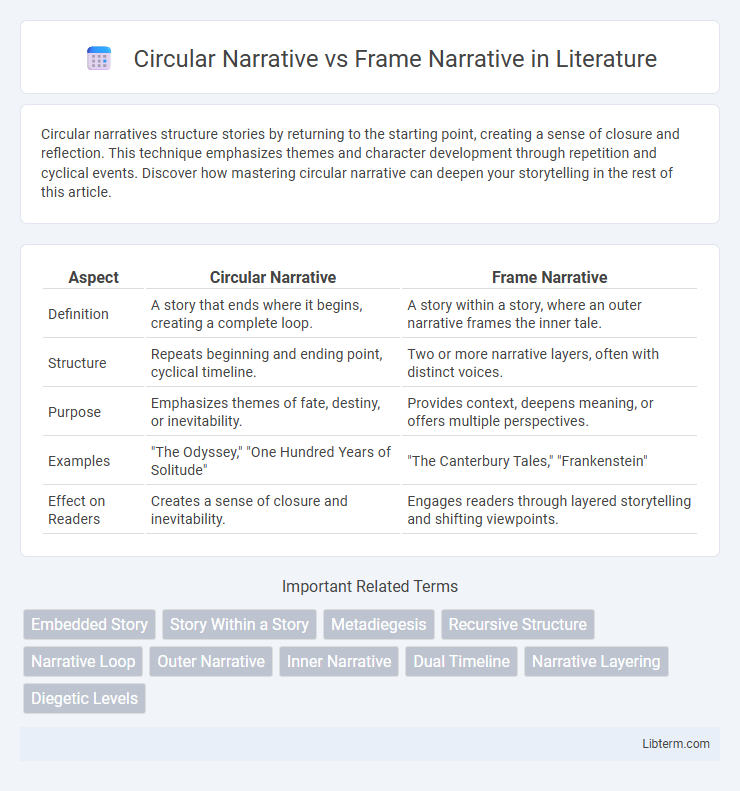Circular narratives structure stories by returning to the starting point, creating a sense of closure and reflection. This technique emphasizes themes and character development through repetition and cyclical events. Discover how mastering circular narrative can deepen your storytelling in the rest of this article.
Table of Comparison
| Aspect | Circular Narrative | Frame Narrative |
|---|---|---|
| Definition | A story that ends where it begins, creating a complete loop. | A story within a story, where an outer narrative frames the inner tale. |
| Structure | Repeats beginning and ending point, cyclical timeline. | Two or more narrative layers, often with distinct voices. |
| Purpose | Emphasizes themes of fate, destiny, or inevitability. | Provides context, deepens meaning, or offers multiple perspectives. |
| Examples | "The Odyssey," "One Hundred Years of Solitude" | "The Canterbury Tales," "Frankenstein" |
| Effect on Readers | Creates a sense of closure and inevitability. | Engages readers through layered storytelling and shifting viewpoints. |
Introduction to Circular and Frame Narratives
Circular narratives revolve around a story structure where the plot ends at the beginning, creating a looping effect that emphasizes themes of fate or inevitability. Frame narratives consist of a story within a story, using an outer narrative to set the context for the inner tale, often enhancing perspective and depth. Both techniques offer unique ways to engage readers by manipulating time and narrative layers.
Defining Circular Narrative Structure
Circular narrative structure revolves around a story that begins and ends at the same point or event, creating a loop that highlights themes of repetition, fate, or inevitability. This structure often employs a chronological or thematic cycle that reinforces the circularity by revisiting key moments or motifs. Unlike linear or frame narratives, circular narrative emphasizes the continuity and interconnectedness of events rather than a straightforward progression or an outer framing story.
What is a Frame Narrative?
A Frame Narrative is a storytelling technique where a main story sets the stage for one or more embedded stories, creating a narrative within a narrative structure. This literary device often provides context, background, or a different perspective to the inner tales, enhancing thematic depth and complexity. Classic examples include Mary Shelley's "Frankenstein" and Chaucer's "The Canterbury Tales," illustrating how frame narratives organize multiple layers of storytelling.
Key Differences Between Circular and Frame Narratives
Circular narratives revolve around a story that ends where it began, creating a loop that emphasizes themes of fate and inevitability. Frame narratives contain a story within another story, using an outer narrative to provide context and framework for the inner tale. The key difference lies in structure: circular narratives focus on repetition and cyclical time, while frame narratives highlight nested storytelling and perspective shifts.
Literary Examples of Circular Narratives
Circular narratives often involve stories that end where they begin, creating a loop that emphasizes themes of fate or inevitability, as exemplified by Joseph Conrad's "Heart of Darkness," where the journey into the Congo mirrors the initial setting on the Thames River. This technique contrasts with frame narratives like Mary Shelley's "Frankenstein," which employs nested stories to provide multiple perspectives within the same overarching storyline. Notable circular narratives also appear in Gabriel Garcia Marquez's "One Hundred Years of Solitude," where the repetition of events across generations highlights the cyclical nature of history.
Famous Works Utilizing Frame Narratives
Frame narratives create a story within a story, guiding the audience through an outer framework to the inner tale, as seen in Geoffrey Chaucer's "The Canterbury Tales" and Mary Shelley's "Frankenstein." These works utilize the frame narrative structure to provide context, develop multiple perspectives, and enhance thematic depth. Circular narratives, by contrast, conclude where they begin, creating a cyclical storytelling experience distinct from the layered approach of frame narratives.
Impact on Reader Experience
Circular narratives create a cyclical reading experience that emphasizes themes of repetition and inevitability, fostering a deeper emotional resonance and contemplation in the reader. Frame narratives provide multiple perspectives within a layered storytelling structure, enhancing engagement through shifting viewpoints and contextual depth. Together, these techniques manipulate time and perspective to enrich the reader's understanding and investment in the narrative.
Narrative Purpose and Thematic Effects
Circular narratives emphasize repetition and the return to the story's beginning to reinforce themes of fate, inevitability, or cyclical time, creating a sense of closure and reflection. Frame narratives use an outer story to set the stage for an embedded tale, enhancing thematic depth by contrasting different perspectives or highlighting storytelling as a means of understanding reality. Both structures serve narrative purpose by shaping readers' engagement with time and theme, but circular narratives stress thematic unity through recurrence, while frame narratives explore multiplicity and context.
When to Use Each Narrative Structure
Circular narrative suits stories emphasizing themes of fate, inevitability, or cyclical patterns, making it ideal for myths or tales exploring repetition over time. Frame narrative works best when embedding multiple related stories within a larger context or providing different perspectives, often used in travelogues or anecdotes linked by a common narrator. Choose circular structure to highlight thematic closure and frame narrative to organize diverse stories cohesively.
Conclusion: Choosing the Right Narrative Form
Selecting between Circular Narrative and Frame Narrative depends on the desired storytelling effect: Circular Narratives emphasize thematic closure and cyclical motifs by returning to the story's starting point, enhancing symbolic meaning and emotional resonance. Frame Narratives offer layered storytelling through embedded stories, providing context, contrast, and multiple perspectives that deepen thematic complexity. Writers should consider narrative purpose, audience engagement, and thematic depth when choosing the structure that best aligns with their creative goals.
Circular Narrative Infographic

 libterm.com
libterm.com